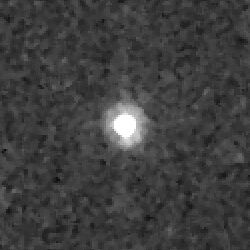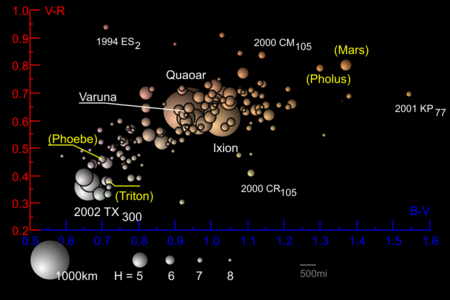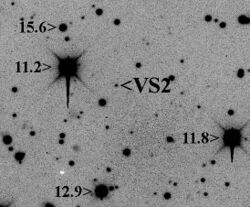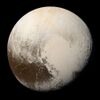Astronomy:(84922) 2003 VS2
 Hubble Space Telescope image of 2003 VS2 taken in 2005 | |
| Discovery[2] | |
|---|---|
| Discovered by | NEAT (644) |
| Discovery date | 14 November 2003[1] |
| Designations | |
| (84922) 2003 VS2 | |
| none | |
| Minor planet category | Plutino[3][4] |
| Orbital characteristics[1][3] | |
| Epoch 13 January 2016 (JD 2457400.5) | |
| Uncertainty parameter 3 | |
| Observation arc | 8830 days (24.18 yr) |
| Earliest precovery date | 17 September 1991 |
| |{{{apsis}}}|helion}} | 42.413 astronomical unit|AU (6.3449 Tm) |
| |{{{apsis}}}|helion}} | 36.456 AU (5.4537 Tm) |
| 39.435 AU (5.8994 Tm) | |
| Eccentricity | 0.075539 |
| Orbital period | 247.64 yr (90451.3 d) |
| Average Orbital speed | 4.75 km/s |
| Mean anomaly | 15.535° |
| Mean motion | 0° 0m 14.328s / day |
| Inclination | 14.777° |
| Longitude of ascending node | 302.792° |
| 114.317° | |
| Physical characteristics | |
| Dimensions | (678±10) × (470±12) × (452±16) km[5] |
| Mean diameter | |
| Mean density | 1.4+1.0 −0.3 g/cm3[6] |
| Rotation period | 7.4175285±0.00001 h[8] |
| Sidereal rotation period | 7.41±0.02 h[9] |
| Geometric albedo | 0.134±0.01[5] |
| Physics | ≈44 K |
| |
| Apparent magnitude | 19.7[10] |
| Absolute magnitude (H) | 4.11±0.38[8] |
(84922) 2003 VS2 is a trans-Neptunian object discovered by the Near Earth Asteroid Tracking program on 14 November 2003.[2] Like Pluto, it is in a 2:3 orbital resonance with Neptune[3][4] and is thus a plutino. Analysis of light-curve suggests that it is not a dwarf planet.[11]
Orbit and rotation
Like Pluto, (84922) 2003 VS2 is locked in the 3:2 mean-motion resonance with Neptune, although its orbit is both less inclined and significantly less eccentric than Pluto's.[1]
(84922) 2003 VS2 has a significant light-curve amplitude of 0.21±0.01. The most likely value of the rotation period is 7.41±0.02 h.[9]
Physical characteristics
(84922) 2003 VS2 has a moderately red surface with a moderately red color indices B−V=0.93, V−R=0.59.[12] Its geometrical albedo is about 0.13.[6]
In 2007, its diameter was initially estimated by the Spitzer Space Telescope at 725±200 km.[13] However, in 2012, this was reduced to 523.0+35.1
−34.4 km after new Herschel Space Telescope observations.[7] In 2019, 2003 VS2 was found to be ellipsoidal in shape based on stellar occultations that occurred in 2013 and 2014;[6] the light curve derived from the occultations suggests that this plutino is not in hydrostatic equilibrium and hence not a dwarf planet.[14] The dimensions of 2003 VS2 are estimated at 627.6 km × 531 km × 494.6 km, with a volume-equivalent diameter 548.3+29.5
−44.6 km.[6] 2003 VS2 has no known satellite that can be used to directly determine its mass, but assuming a density of 1 g/cm3, typical of mid size TNO's,[15] gives a mass estimate of about 7.5×1019 kg.

See also
- Sedna, another large trans-Neptunian object discovered the same day (14 November 2003)
References
- ↑ 1.0 1.1 1.2 "JPL Small-Body Database Browser: 84922 (2003 VS2)". https://ssd.jpl.nasa.gov/sbdb.cgi?sstr=84922. Retrieved 7 April 2016.
- ↑ 2.0 2.1 Marsden, Brian G. (2003-11-16). "MPEC 2003-W02 : 2003 VS2". IAU Minor Planet Center. Harvard-Smithsonian Center for Astrophysics. http://www.cfa.harvard.edu/mpec/K03/K03W02.html. Retrieved 2010-01-06.
- ↑ 3.0 3.1 3.2 Buie, Marc W. (2008-02-05). "Orbit Fit and Astrometric record for 84922". SwRI (Space Science Department). http://www.boulder.swri.edu/~buie/kbo/astrom/84922.html. Retrieved 2008-07-23.
- ↑ 4.0 4.1 "MPEC 2006-X45 : Distant Minor Planets". Minor Planet Center & Tamkin Foundation Computer Network. 2006-12-21. http://cfa-www.harvard.edu/iau/mpec/K06/K06X45.html. Retrieved 2008-07-23.
- ↑ 5.0 5.1 5.2 Vara-Lubiano, M. et al. (2022). "The multichord stellar occultation on 2019 October 22 by the trans-Neptunian object (84922) 2003 VS2". Astronomy & Astrophysics 663: A121. doi:10.1051/0004-6361/202141842. Bibcode: 2022A&A...663A.121V.
- ↑ 6.0 6.1 6.2 6.3 6.4 Benedetti-Rossi, Gustavo; Santos-Sanz, P.; Ortiz, J. L.; Assafin, M.; Sicardy, B.; Morales, N. (2019). "The trans-Neptunian object (84922) 2003 VS2 through stellar occultations". The Astronomical Journal 158 (4). doi:10.3847/1538-3881/ab3b05.
- ↑ 7.0 7.1 7.2 Mommert, Michael; Harris, A. W.; Kiss, C.; Pál, A.; Santos-Sanz, P.; Stansberry, J.; Delsanti, A.; Vilenius, E. et al. (May 2012). "TNOs are cool: A survey of the trans-Neptunian region—V. Physical characterization of 18 Plutinos using Herschel-PACS observations". Astronomy & Astrophysics 541: A93. doi:10.1051/0004-6361/201118562. Bibcode: 2012A&A...541A..93M.
- ↑ 8.0 8.1 Santos-Sanz, P.; Lellouch, E.; Groussin, O.; Lacerda, P.; Muller, T.G.; Ortiz, J.L.; Kiss, C.; Vilenius, E. et al. (August 2017). ""TNOs are Cool": A survey of the trans-Neptunian region XII. Thermal light curves of Haumea, 2003 VS2 and 2003 AZ84 with Herschel/PACS". Astronomy & Astrophysics 604 (A95): 19. doi:10.1051/0004-6361/201630354. Bibcode: 2017A&A...604A..95S.
- ↑ 9.0 9.1 Sheppard, Scott S. (August 2007). "Light Curves of Dwarf Plutonian Planets and other Large Kuiper Belt Objects: Their Rotations, Phase Functions, and Absolute Magnitudes". The Astronomical Journal 134 (2): 787–798. doi:10.1086/519072. Bibcode: 2007AJ....134..787S.
- ↑ "AstDys (84922) 2003VS2 Ephemerides". Department of Mathematics, University of Pisa, Italy. http://hamilton.dm.unipi.it/astdys/index.php?pc=1.1.3.0&n=84922. Retrieved 2009-12-07.
- ↑ Tancredi, Gonzalo (2009). "Physical and dynamical characteristics of icy "dwarf planets" (plutoids)". Proceedings of the International Astronomical Union Symposium S263 5: 173–185. doi:10.1017/S1743921310001717. Bibcode: 2010IAUS..263..173T. (Dwarf Planet & Plutoid Headquarters)
- ↑ Tegler, Stephen C. (2007-02-01). "Kuiper Belt Object Magnitudes and Surface Colors". http://www.physics.nau.edu/~tegler/research/survey.htm. Retrieved 2009-12-30.
- ↑ Stansberry, John; Grundy, Will; Brown, Mike; Cruikshank, Dale; Spencer, John; Trilling, David; Margot, Jean-Luc (2008). "Physical Properties of Kuiper Belt and Centaur Objects: Constraints from Spitzer Space Telescope". in Barucci, M. Antonietta; Boehnhardt, Hermann; Cruikshank, Dale P.. The Solar System Beyond Neptune. University of Arizona press. pp. 161–179. ISBN 978-0-8165-2755-7. Bibcode: 2008ssbn.book..161S. http://www.lpi.usra.edu/books/ssbn2008/7017.pdf.
- ↑ Benedetti-Rossi, Gustavo; Santos-Sanz, Pablo; Ortiz, Jose Luis; Assafin, Marcelo; Sicardy, Bruno; Vieira-Martins, Roberto; Braga-Ribas, Felipe (2019). "Three Stellar Occultations by the Plutino Object (84922) 2003 VS2". Epsc-DPS Joint Meeting 2019 2019: EPSC-DPS2019-435. Bibcode: 2019EPSC...13..435B.
- ↑ Grundy, W.M.; Noll, K.S.; Buie, M.W.; Benecchi, S.D.; Ragozzine, D.; Roe, H.G. (2019). "The mutual orbit, mass, and density of transneptunian binary Gǃkúnǁ'hòmdímà (229762 2007 UK126)" (in en). Icarus 334: 30–38. doi:10.1016/j.icarus.2018.12.037. Bibcode: 2019Icar..334...30G.
External links
- Huge rock-ice body circles Sun (Palomar Photo)
- 2003 VS2 precovery (18 Nov. '03 Major News about Minor Objects)
- (84922) 2003 VS2 at the JPL Small-Body Database
 |




